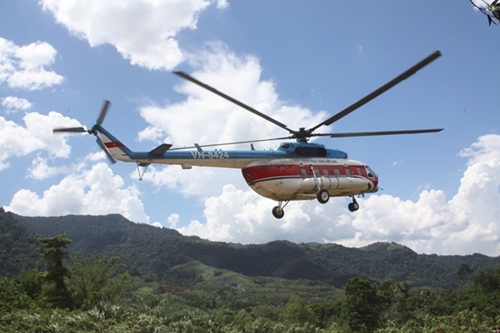These achievements did not come incidentally but resulted from their specific joint cooperation activities, especially in searching for missing-in-action servicemen from the war.
The “opener”
A few days prior to the 25th anniversary of the normalization of Vietnam-US diplomatic relations (July 12), the Vietnam Office for Searching Missing Persons (VNOSMP) and the United States Agency for International Development (USAID) signed a Memorandum of Intent (MoI) to improve the capacity of DNA analysis of unidentified remains of servicemen missing in action during the war in Vietnam.
As one of the few reporters who attended the meaningful signing ceremony, I, a reporter from the People’s Army Newspaper (PAN), met with US Ambassador to Vietnam Daniel J. Kritenbrink and heard his speech. The American diplomat affirmed that Vietnam-US relations over the past 25 years amount to a very interesting story, an impressive journey and a fantastic model for the world, about how former foes can find a common way and cooperate in overcoming the past to obtain striking progress.
    |
 |
|
Helicopter of Army Corps 18 doing task of searching for American servicemen mising in action from the war in Dong Hoi (Quang Binh) in August 2016 |
Ambassador Kritenbrink talked about how many people have called the progress that Vietnam and the US have made in their bilateral ties a miracle. He remembered former US Ambassador to Vietnam Pete Peterson, who made important contributions to boosting the Vietnam-US relationship normalization and fostering the bilateral relations, had affirmed that the overall progress of the Vietnam-US relations is brilliant but not by chance. These achievements have resulted from bravery, goodwill, and great efforts from both sides. And the “opener” in the normalization process was the Vietnamese government’s willingness to cooperate with the US in searching for missing-in-action servicemen.
The so-called “opener” that Peterson mentioned above was established in 1985 when Vietnam and the US started the first joint field activity to search for US servicemen listed as missing-in-action during the war in Vietnam. It is said that the two sides’ cooperation in this field had begun even earlier via a series of their high-level discussions.
By June 2019, the two sides had collected 727 remains of US servicemen missing in action during the war in Vietnam through hundreds of joint field activities. More importantly, according to Vietnamese Deputy Minister of Foreign Affairs Bui Thanh Son, the cooperation has helped the two countries better understand each other's goodwill to further promote cooperation in other areas.
Looking back at documents about the Vietnam-US cooperation, I was lucky to find a photo of a letter from the CEO of the National League of POW/MIA Families Ann Mills-Griffiths. It was sent to a ceremony held in December 2018 in Hanoi to celebrate the 30th anniversary of sustained US-Vietnam joint field activities. In the letter, she wrote that after nearly 52 years, her family found the remains of her brother - Commander James B. Mills, US Navy Reserve, missing since September 21, 1966 when he was flying a F4B Phantom fighter from USS Coral Sea aircraft carrier. This was a miracle. Her family was very grateful to those who had made great efforts over the past four decades to bring about such a result.
Perhaps, all who joined that ceremony and listened to Ann Mills-Griffiths’ letter could perceive the deep gratitude that the Mills-Griffiths as well as other US families would like to express to the Vietnamese government and people for supporting the search and repatriation of remains of US servicemen missing in mission over the past time.
Expectations from both sides’ great efforts
The work of searching, repatriating and identifying remains of soldiers missing in action during the war plays an important cultural and spiritual role for both governments and people of Vietnam and the US. Therefore, a two-way support mechanism and cooperation between the two countries in this meaningful field has been opened. It is expected that this mechanism will bring even greater results.
Since the end of the war, the Vietnamese government and the Vietnam People's Army have attached much importance to the identification and collection of remains of Vietnamese soldiers who sacrificed their lives in the war. In addition, overcoming consequences and dealing with humanitarian issues left behind from the war are top priorities in Vietnam-US relations. However, remains of over 200,000 Vietnamese soldiers reported fallen or missing during the war have not been found yet. Search programs have faced a number of challenges, including limited DNA analysis capacity and a lack of information.
So far, Vietnam has asked the US to support the search and collection of remains of Vietnamese fallen soldiers. On his visit to Vietnam last October, during his meeting with Vietnamese Defense Minister General Ngo Xuan Lich, US Defense Secretary Mark Esper pledged that the US would further assist Vietnam in this field in the time to come. Thus, the signing of the MoI between the VNOSMP and USAID actually realized this commitment. According to this deal, the USAID will provide Vietnam with the best cutting edge technologies for DNA extraction and analysis. It will also cooperate with the Vietnamese side to boost the efficiency of the performance of Vietnamese labs with an aim to enabling Vietnam to find and identify more Vietnamese soldiers missing in action during the war.
It is obvious that the search for remains of missing-in-action servicemen has become a symbol of healing the wound of war in Vietnam-US relations. This work is also expected to open the door for further cooperation in various other fields that address war aftermath between the two countries, such as mine action, Agent Orange/dioxin cleanup, and humanitarian programs to support Vietnamese people with disabilities, to name but a few.
Reported by Vu Hung
Translated by Minh Anh